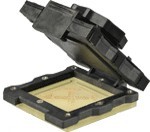These sockets are available for almost any IC package style, size, lead-count and lead-pitch down to 0.5mm pitch: BGA, MLF/QFN, uBGA, SOIC, QFP and also custom packages or die. Furthermore, these sockets provide flexibility in the PCB mounting method: SMT, raised SMT, through-hole, or compression mount.
-
SMT (pin type -30) uses a standard reflow process to mount the sockets to the target PCB. These sockets mount in the same footprint as the IC, but typically require a mimimum clearance of 6mm betyond the package's periphery. In situations where adjacent components lie in this area, either the socket body can be modified to clear the components, or a special raised SMT (pin types -28 or -29) pin can be used in place of the standard SMT pin. These pins raise the socket body from 2-5mm above the PCB. Although this method does not require any drilled holes in the target PCB, it is highly recommended to provide two such plated holes in order to accomodate mounting pegs and greatly strengthen the physical connection between the socket and PCB. Alternatively, epoxy can be used to strengthen the connection, but this more or less creates a permanent bond between the socket and PCB.
-
Through-hole (pin type -70) requires plated holes to be drilled in the PCB into which the pins of the socket will be soldered. This provides for a very robust and reliable electrical and mechancial connection. However, the electrical performance is reduced due to the longer pin lengths. This method is highly suitable for burn-in applications.
-
Compression (pin type -90) mount removes the need for any soldering and just requires the socket to be held to the PCB via screws. The benefit of this method is that it allows the customer to easily attach the socket to the target board in the lab, without the extra cost, lead-time, and potential problems caused by sending the board to an assembly house. However, this method requires that the target PCB has mounting holes drilled to accomodate the mounting screws and socket body alignment posts. Furthermore, depending on the size of the IC, the PCB thickness, etc., a backing plate is required to provide rigidity and ensure the socket pins contact the PCB pads. This plate can usually be modified to accomodate any backside compononents.
 |
 |
 |
|
SMT (-28, -29, -30) |
Through-Hole (-70) |
Compression (-90) |
SOCKET BODY VERTICAL OFFSET
The following table shows the vertical clearance of the socket body from the PCB. This is only applicable to the SMT mounting style. In situations where the clearance is insufficient, or the standard SMT pin is preferred, it is possible to modify the socket body to accomodate for adjacent components.
|
Pitch |
Vertical Offset Using Special Raised SMT
(-28) |
Vertical Offset Using Raised SMT
(-29) |
Vertical Offset Using Standard SMT
(-30) |
|---|
|
0.50-0.75 |
N/A |
2.3 |
0.4 |
|
0.8 |
4.5 |
2.8 |
0.6 |
|
1.00 |
4.5 |
3.2 |
0.8 |
|
1.27 |
N/A |
5.0 |
1.2 |
Dimensions in mm
FEATURES & BENEFITS
-
Easily exchange ICs in your system
-
High bandwidth: 3GHz @ -1dB
-
Available for any IC package style: BGA, uBGA, CSP, QFN/MLF, LGA, PGA, SOIC, QFP, custom or die
-
Any lead count, grid and package size
-
Minimum 0.5mm lead pitch
-
Maximum 40g force per contact
-
Mounts to same PCB footprint as the IC (no holes required for SMT version)
-
Low profile: <10mm high with IC
-
Minimal keepout area: approx. 6mm beyond ICs periphery
-
Raised SMT version available for lifting socket over adjacent components
-
Heat dissipation via lid cut-out or integrated heatsink
-
Thermal expansion, shock & vibration absorbed by contact design
-
LGA contact design can also be used for board-to-board connections
-
Standard-process design & manufacturing = lower cost and tailored to your needs
|
|




 /5
/5 
文章评论(0条评论)
登录后参与讨论